No matter where you are in the world, chances are probably pretty good you will encounter plantains. No, I’m not talking about the cooking banana, but instead an herb that’s usually greeted as a weed. And boy, is it a persistent one!
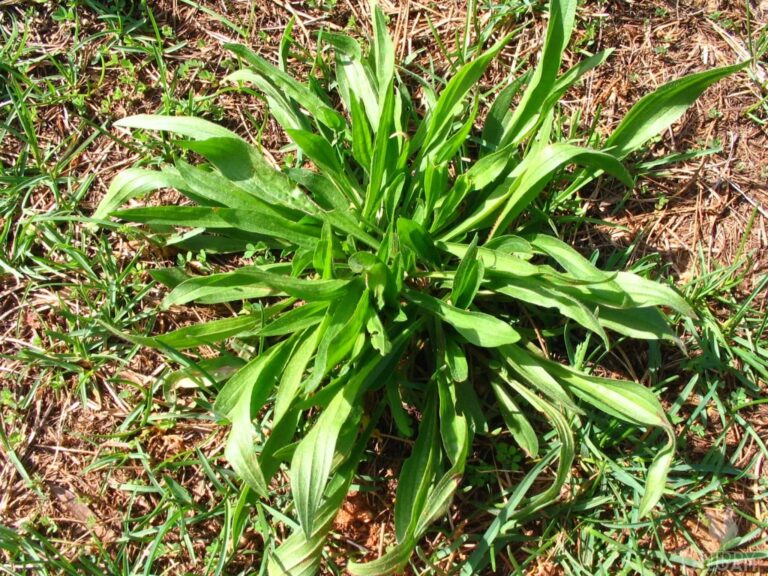
Plantain is infamous for growing absolutely anywhere, and all kinds of soils, and virtually every garden it can take root in, and even up through cracks in the concrete.
It isn’t harmful, and various primitive civilizations have used it as a beneficial herb, but you’ve got to be careful that you aren’t dealing with a harmful lookalike.
Plantain species don’t have many, but they do have some, and I’ll tell you about the most common lookalikes below.
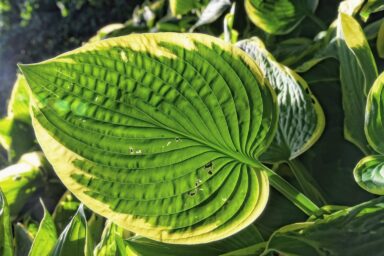
Table of Contents
1. Hosta (Hosta spp.)
Hosta is a generic name for what are, in actuality many different plant species, though many of them are quite similar.
It’s a perennial plant, meaning it comes back year after year, making it a favorite among gardeners.
You’ll notice the leaves are often heart-shaped or ellipsoid and can have either a glossy or subdued sheen.
Hostas hail from eastern Asia, originally, but have made their way across the world and are now a common sight in gardens all over America and much of Europe.
You might mistake Hostas for plantain because of their broad leaves, especially when the Hosta is younger.
But unlike plantain, Hostas are typically known for their larger, leafier foliage overall that comes in a variety of colors and textures.
In most cases, the easiest way for you to differentiate a Hosta from a plantain is by the size and color of the leaves.
Hostas have larger leaves compared to plantains, and they come in a much wider range of colors, including the usual green but also to blue-green and even variegated, a fancy word for varieties with white or yellow patterns.
Note that Hostas are generally safe plants for people, but all parts of the plant (most species) can be toxic to dogs and cats if ingested. Pet owners take care.
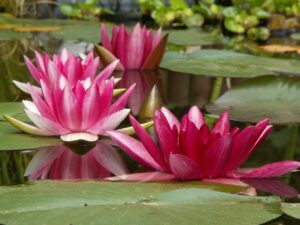
2. Lilies (Lilium spp.)
Lilies are another plant genus with many species that could potentially be confused with plantains.
Perennials, lilies are mostly known for their striking and elegant flowers, which come in a multitude of colors and shapes.
And these flowers are also what will allow you to tell a lily apart from a plantain: all common lilies produce large and obvious flowers that often have a subtle, perfume-like, sweet scent.
Plantains, on the other hand, produce small, inconspicuous flowers on reedy spikes. A lily’s tall, slender stems and lance-shaped leaves further them apart from the broader, shorter plantain.
Lilies are beloved by many cultures around the world for their beauty and symbolism, but caution is advised when handling lilies or if you have any pets.
All parts of these beauties are immensely toxic to cats and dangerous for dogs, causing severe kidney damage if they eat them.
Be sure to place your lilies where curious pets can’t reach them and always keep an eye on them.
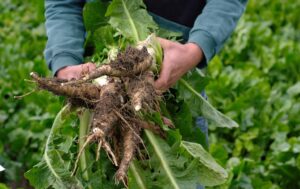
3. Chicory (Cichorium intybus)
A common sight in fields and along roadsides, chicory is a fascinating plant notable for its bright blue flowers, and when not in bloom, it’s often mistaken for plantain.
Chicory is an herbaceous perennial native to Europe and found throughout central Russia, and it’s one with an interesting history.
It’s also known by other names like blue sailors, coffeeweed, and Italian dandelion.
The overall structure of these plants is similar, but with a trained eye, you can spot chicory easily.
Chicory has a somewhat woody structure, growing up to 3 ½ feet in height, unlike the plantain which tends to stay somewhat closer to the ground. Its leaves are also larger and more serrated than those of plantain.
It’s most distinguishing feature, however, is its flowers. Chicory’s flowers are typically a bright and alluring blue, very rarely white or off-white, and the plant is in bloom from June until the first frost.
Chicory is safe overall and generally OK to eat, and the roots have been used as a coffee substitute and for seasoning meat.
Roasted and ground, they create a rich, slightly bitter flavor that can give you a little perk if coffee isn’t around or spice up your meal.
4. Wood Sorrel (Oxalis spp.)
Another genus of plants that might easily be mistaken for plantain is Wood Sorrel.
Native to various regions around the world in one kind or another, Wood Sorrel can typically be found growing in shady locations and moist soil conditions.
A small and delicate plant, in ideal conditions it is often found carpeting forest floors. It is also a common garden invader, popping up in garden beds and rich, tilled soil when least expected or wanted.
The overall growth habit of Wood Sorrel is what will probably confuse you, but it’s the individual leaves that are most likely to clue you in you are dealing with a different plant.
Wood Sorrel’s leaves are divided into three heart-shaped leaflets, giving them a vaguely clover-like appearance. This is in stark contrast to the broad, oval leaves of Plantains.
The flowers themselves are also usually yellow, pink or white, another good way to tell it apart from Plantain, which typically grows subtle, small green-tinted flowers.
Broadly, Wood Sorrel is safe but with some big caveats: the sour, lemon flavor of wood sorrel leaves leads to it being eaten in salads or as a garnish.
However, they contain loads of oxalic acid, which in large amounts can cause stomach upset and inhibit calcium absorption in the body.
Generally safe to consume in moderation, overconsumption should be avoided and always consult your doctor if you are taking any prescription medication.
5. Curly Dock (Rumex crispus)
A common fixture in wet areas or any place that regularly floods (or gets irrigation), you might come across the perennial broadleaf known as Curly Dock.
This peculiarly named plant is native to Europe and Western Asia but has since become invasive or even naturalized in many other countries.
Curly Dock usually grows anywhere from 2 to 5 feet tall and sprouts erect flowering stems. The flowers themselves are small off-white with a green or yellow-green tint, arranged in clusters on each stalk.
Curly Dock can be confused for plantain because of the way it grows and the shape of the leaves overall.
However, Curly Dock can be identified by its distinct wavy or “curly” leaf margins, which are quite different from the smooth edges on the leaves of plantain.
Curly Dock is a weed but not just any weed; it has been used in ancient indigenous European herbal medicine practices.
But be warned: While some parts of the plant are safe and even edible, other parts are dangerous and the plant is considered poisonous to cows, horses, goats and sheep.
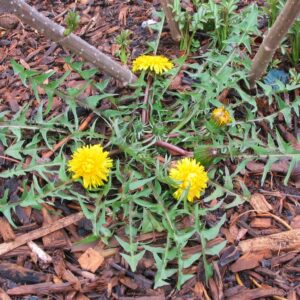
6. Dandelion (Taraxacum officinale)
Dandelion, probably that most well-known and hated of weeds, is yet another pesky plant that could be mistaken for Plantain.
Like Plantain, It grows practically anywhere, including lawns to meadows, gardens, playgrounds, beaches and even through cracks in the pavement and in walls.
But unlike plantain with its vein-riddled, oval leaves, you will easily tell dandelion apart thanks to its rosette, toothed leaves.
That leaf shape is what gave the plant its name, derived from the original French meaning “lion’s tooth”.
Anyway, the leaves radiate from a central point close to the ground at the point of origin, and that growth habit is what makes dandelions such an eyesore on lawns.
And of course, Dandelion’s most distinguishing feature is that cheery yellow, sunflower-like bloom. They are a stark contrast to plantain’s flowers, which are rather inconspicuous atop thin, leafless spikes.
But, as much as you might hate them, spare a care for the dandelion! Dandelions have been used for centuries as a source of food, and not just for bees!
The entire plant, from flower to root, is safe, nutritious and edible. Its leaves can make a great addition to salads, and the roots, when roasted, can be used as a coffee substitute like chicory up above. Pretty neat!
Do remember, though, to only pick from areas you know to be free of pesticides and pollutants: Dandelions are constant targets of herbicides.
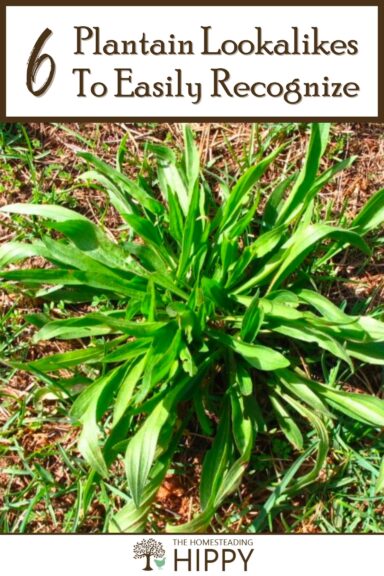
Tim is a farm boy with vast experience on homesteads, and with survival and prepping. He lives a self-reliant lifestyle along with his aging mother in a quiet and very conservative little town in Ohio. He teaches folks about security, prepping and self-sufficiency not just through his witty writing, but also in person.
Find out more about Tim and the rest of the crew here.
